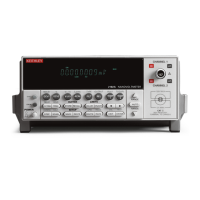Voltage and Temperature Measurements 2-23
Applications
Low-resistance measurements
The Model 2182 can be used with a current source to measure resistances at levels well below
the capabilities of most conventional instruments. The following paragraphs discuss low-
resistance measurement techniques and include some applications to test switches.
Measurement techniques
Techniques used to measure resistances in the normal range are not generally suitable for
making low-resistance measurements because of errors caused by voltage drops across the test
leads. To overcome these limitations, low resistance measurements are usually made using the
4-wire (Kelvin) connections shown in Figure 2-10. A current source forces the current (I)
through an unknown resistance, developing a voltage across that device. Even though the test
lead resistance, R
LEAD
, is present, it does not affect the current through R
DUT
because I is
assumed to be a constant current source with high output impedance. Also, since the voltmeter
has a very high input resistance (very low leakage current), the current through the sense leads
will be negligible, and the voltage drop across R
LEAD
will be essentially zero. Thus, the voltage
measured by the meter will be essentially the same as the voltage across the unknown resistance,
R
DUT
.
Figure 2-10
4-Wire low-resistance measurement technique
Since the current through the measured resistance and the voltage across the device are both
known, the value of that resistance can easily be determined from Ohm's law:
R
DUT
= V
M
/I
R
LEAD
R
LEAD
I
V
OFFSET
R
DUT
V
M
Voltmeter
R
LEAD
R
LEAD
R
DUT
=
V
M
I
Current
Source

